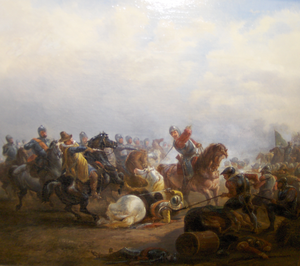War of the Foot
| War of the Foot | |||||
|---|---|---|---|---|---|
| |||||
| Belligerents | |||||
| Kingdom of the Fhainn | Penthravic League | ||||

The War of the Foot was a conflict in western metropolitan Faneria from 1504 to 1508 between the Kingdom of the Fhainn and the League of the Penthrav, a Coscivian colony centered around the cities of Minaeh (modern-day Mynach) and Kurikila. Ostensibly beginning as a pogrom against Fhainnin traders in Penthrav, the war was in practice fought over the integration of the Cairnlan Peninsula by Faneria, surrounding Penthrav territories and threatening the dominance of the League over sea trade in the eastern Kilikas.




Background
Penthrav had existed since the fifth century as a loose alliance of Coscivian settler-cities and trade posts, acting as the terminal point of the southeast-northwest Vandarch trade route that allowed trade from southern Levantia and the wider world to avoid extensive travel in the Kilikas Storm Belt. The colonies were deeply invested in the interstate politics of the Vandarch Basin and actively supported the traditional regional power, Daingean, in its wars against the Kingdom of the Mar and later the Kingdom of the Fhainn. After Daingean fell to the Kingdom of the Fhainn in 1470 following the Dunlann War, the growing cost of trade along the Vandarch route crashed, spurring on dramatic increases in tariffs by both parties which brought about constant trade disputes between Penthrav and Faneria into conflict. While a similar trade war was ongoing on the southern end of the Vandarch, an invasion into the Principality of Itheachan in 1481 resulted in a pyrrhic victory and ended plans to conquer Itheachan and Turlann in the immediate future.
The critical nature of trade for the Throne's direct income in this period could not be understated, as taxes were traditionally raised through import and export fees and citizens and nobles funding public expenses. While title fees provided steady income, it was a saturated source that required conquering new regions to expand. In addition, 1476-1483 saw a rapid succession of several Rihs, which allowed the Elector-Princes (Vicar-Princes following 1481) to exercise their own power unchecked. Ruaridh II of Faneria, who had been a key figure in maintaining his family's succession of the Throne through placation and outright bribery, took the Throne in 1483 with large debts to his own electors and a state apparatus which had been steadily decentralizing since the mid-13th Century. In response to these crises, Ruaridh II immediately began organizing an invasion of Gleathan, breaking through the Croilaen Gap and annexing the Sheafhainn territories in the region as personal holdings. Doing so with his own army was a major risk, but allowed the Rih to reach and annex the Gaelic regions surrounding the southernmost Coscivian colony, Kilfenora, at the end of the campaign in 1490. The near-doubling of directly ruled Throne lands allowed for the finances of the Kingdom to stabilize and clearly indicated that a war over control of the terminal continental ports of the Vandarch Route was inevitable. Kilfenora itself was evacuated prior to being seized by the Throne in 1498. Open war was avoided after the annexation only due to the incoherent state of the Penthravic military, which consisted entirely of local militias composed of a relatively small permanent Coscivian population and the private armies of the trading companies and cartels which controlled the League; following 1498, a collective effort to source mercenaries from the Kilikas as far as Vithinja and from allied Sheafhainn cities and principalities was undertaken in preparation for a future war.
The war itself began in response to one of many ongoing acts of violent antagonism between Throne and Penthravic traders; while constant Coscivian piracy and occasional eruptions of Coscivian-Fhainnin conflict did exist within the Penthrav, the key incident for which the war would be named occurred in 1502 between the Penthravic tradelord Manxán Dannemór and an unnamed Throne-sanctioned merchant. The merchant in question, being accused of shorting Dannemór on fabrics, declared himself in the right based off of measuring by foot-lengths on each bolt of cloth. Dannemór, presumably enraged by the claim, had the merchant's foot cut off and shipped to Great Kirav to compare to the feet of the Marble Emperor. While cheating was always present to a degree in major trade centers, Fhainnin traders under Throne protection had been encouraged to do so in the preceding years and had begun to employ a variety of increasingly complicated forms of goods fraud.
Early Violence
Critically, Dannemór's act had broken an understanding among Penthrav's House of the Meritorious, its de facto executive and legislative body, that war would need to be delayed and such offenses soothed over until Ruaridh II took more drastic action. Giving the Fanerian Throne a legitimate cause for offense did not bear the same weight as a traditional casus belli in southern Levantia during the period, but it was necessary in order for Ruaridh to use the war to further reverse his decentralized position. Following news of the severing of the titular Foot, the Rih invoked his rights to wartime tithes of soldiers from the Vicar-Princes to supplement his personal army,
- rhetoric - rights to defend cathedral in leighlinbridge, Northern Rite vs Catholic, threaten vicar's power - need some names (really, need thronelands/subjects by periods map set)
- Cairnlan peninsula, owned by tradelord, attacked in response - army marched through Penthravic territory without permission to do so
- cairnlan campaign over quickly, most preparations in south
- stop on Fanerian goods begins
Escalation and Open War
Fhainnin Victory and Aftershocks